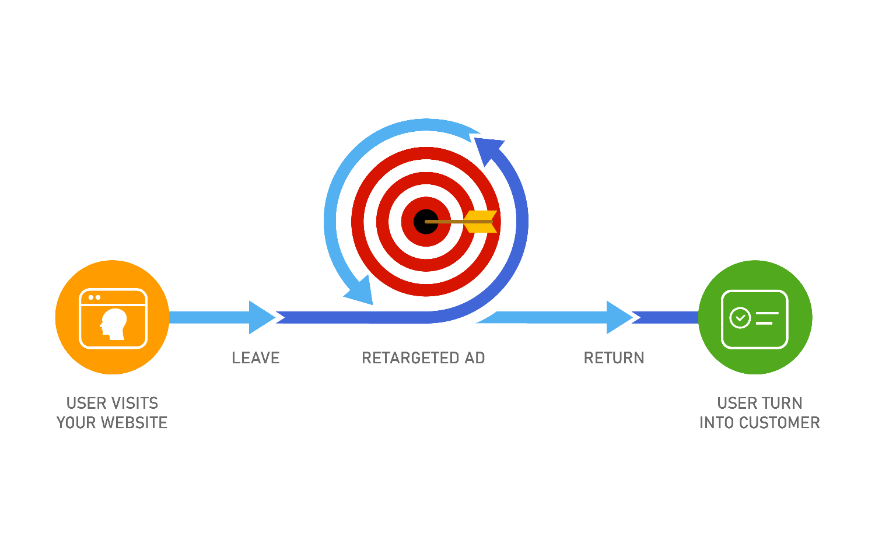
Retargeting and remarketing are important digital marketing tactics. They position your messages in front of target audiences who are already familiar with your brand. While these aren’t new concepts, strategies and approaches continue to shift and evolve with the ever-changing digital landscape.
Retargeting vs. Remarketing
Marketers often use the terms “remarketing” and “retargeting” interchangeably, yet there are some distinct differences. Remarketing involves tactics designed to re-engage with a prospect who has already interacted with your brand in some way. Consider that a whopping 97 percent of visitors that leave a website never return. Remarketing makes those initial visits count. Tactics include digital content such as emails, search, social media, video, website and content engagement across other platforms and publications. Other remarketing techniques include in-person events, print media and direct mail.
Retargeting falls under the larger umbrella of remarketing. It is a more specialized process that centers around paid digital advertising. It strategically positions paid ads in front of audiences who already interacted with your brand elsewhere. Retargeting is used in the context of ads and has a specific cookie tracking process. Use remarketing to re-establish engagement from any possible initiative with any method.
What B2B Marketers Need to Know About Ad Retargeting
Because retargeting falls under the umbrella of paid advertising, there is a specific practice of delivering personalized ads or other content to users who have interacted with your website, social media, search results or other content. The goal of retargeted ads is to link users back to your website and guide them through the sales funnel.
To retarget a prospect, a “pixel” (small piece of code) must be added to your website via a retargeting provider. This code isn’t visible to site visitors, but it does place a cookie in their browser. This cookie adds them to a segmented audience list and allows your ad to “follow” that segment across the web.
Later, when “cookied” visitors browse other websites within the Display Network—a group of more than two million websites, videos and apps where your ads can appear—the cookie tells your retargeting provider when to serve ads. This ensures delivery of your ads only to people who previously visited your site or other content.
Then, segmented audiences are filtered and retargeted based on specific criteria. Criteria include viewing a particular product, content or webpage, spending a specific amount of time on a page or interacting with a chatbot or online shopping cart.
Six Essential Types of Retargeting

Retargeting ads yield high engagement and conversion rates. This is because it leverages previous engagement and focuses on users who showed an interest in your products or services. Consider the following retargeting methods:
- Visitor retargeting is the most basic form of retargeting that shows ads to your past website visitors as they visit websites that are part of Display Network and use its applications. Gear this broadly toward any individual who visits a website, rather than a segmented effort.
- Dynamic retargeting allows more specialized segmenting to show ads to visitors who browse or interact with specific products or services on your website. This includes a product catalog or shopping cart, but it also provides targeted ads after a prospect interacted with content that addresses client challenges related to a product and service.
- Mobile app retargeting shows ads to visitors who used a brand’s specialized mobile app or mobile website. Users downloaded 218 billion apps in 2020, making mobile applications a vital place for users to re-encounter products and services through targeted ads.
- Search retargeting brings ads to visitors when they conduct internet search queries related to your brands and products. Search ads are positioned strategically when prospects conduct follow-up research relevant to your solutions. This keeps your brand top of mind when prospects are closer to making a purchase decision.
- Video retargeting brings your ads to visitors who opened your brand’s YouTube, social media or related branded videos. It specifically delivers video ads to watchers so the ad appears in the same medium that the prospect prefers.
- Email list retargeting is a more manual form of retargeting. After uploading a segmented list of prospect or client email addresses, visitors on these lists will see your display ads as they browse through different websites. By using data from email interactions, segmented audiences can receive highly targeted ads.
Every Stage of the Buyer’s Journey

Whichever method you choose, the practice of remarketing and retargeting addresses the key element of engaging with prospects and clients at every stage of the buyer’s journey. When the design and messaging of ads address prospects’ needs and correspond to where they are in the decision-making process, remarketing and retargeting can significantly impact how prospects envision and interact with your brand.
